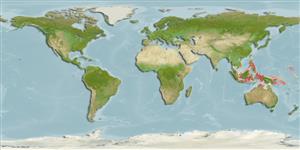分類 / Names
共通名の | 類義語 | Catalog of Fishes(部類, 種) | ITIS | CoL | WoRMS | Cloffa
>
Syngnathiformes (Pipefishes and seahorses) >
Syngnathidae (Pipefishes and seahorses) > Syngnathinae
Etymology: Apterygocampus: Greek, apterygos = without fins + Greek, kampe = curved (Ref. 45335).
More on author: Weber.
Environment: milieu / climate zone / depth range / distribution range
生態学
海 底生の; 深さの範囲 3 - 10 m (Ref. 90102). Tropical
Western Central Pacific: Indonesia, the Philippines and Papua New Guinea.
サイズ / 重さ / 年齢
Maturity: Lm ? range ? - ? cm
Max length : 3.0 cm SL オス/雌雄の選別がない; (Ref. 48635)
簡単な記述
形態学 | 形態計測学
背鰭 (合計): 17-20. Holotype from 'reef', a brooding male lacks dorsal and pectoral fins, while those fins present in its pouch-larvae. Planktonic specimens at similar size of adults have dorsal fin and pectoral fins. The female looks much like female Acentronura, but have a moderately large caudal fin. The pouch of the male holotype is sac-like, also similar to Acentronura (Ref. 48635).
Specimens taken at the surface with nightlight and dipnet. May also be found on shallow mudflats with sparse seagrasses. Ovoviviparous (Ref. 205). The male carries the eggs in a brood pouch which is found under the tail (Ref. 205). Found in association with Briareum soft corals (Ref 90102).
Life cycle and mating behavior
成熟 | 繁殖 | 放精 | 卵 | 生産力 | 幼生
Male carries the eggs in a brood pouch (Ref. 205).
Dawson, C.E., 1985. Indo-Pacific pipefishes (Red Sea to the Americas). The Gulf Coast Research Laboratory Ocean Springs, Mississippi, USA. (Ref. 5316)
Human uses
より多くの情報
Age/Size成長体長-重さLength-length体長組成形態計測学形態学幼生幼生の動力補充豊度BRUVS
参考文献水産養殖水産養殖の紹介緊張遺伝子のElectrophoreses遺伝病気行列NutrientsMass conversion
協力者画像Stamps, Coins Misc.音シガテラ(食中毒の名前)速度泳ぐ 型式カマOtoliths脳視覚
用具
特記事項
XMLをダウンロードして下さい
インターネットの情報源
Estimates based on models
Preferred temperature (Ref.
123201): 28.5 - 29.3, mean 28.8 °C (based on 509 cells).
Phylogenetic diversity index (Ref.
82804): PD
50 = 1.0000 [Uniqueness, from 0.5 = low to 2.0 = high].
Bayesian length-weight: a=0.00037 (0.00016 - 0.00085), b=3.18 (2.99 - 3.37), in cm total length, based on LWR estimates for this (Sub)family-body shape (Ref.
93245).
栄養段階 (Ref.
69278): 3.1 ±0.4 se; based on size and trophs of closest relatives
回復力 (Ref.
120179): 高い, 15か月以下の倍増期間の最小個体群 (Preliminary K or Fecundity.).
Fishing Vulnerability (Ref.
59153): Low vulnerability (10 of 100).
